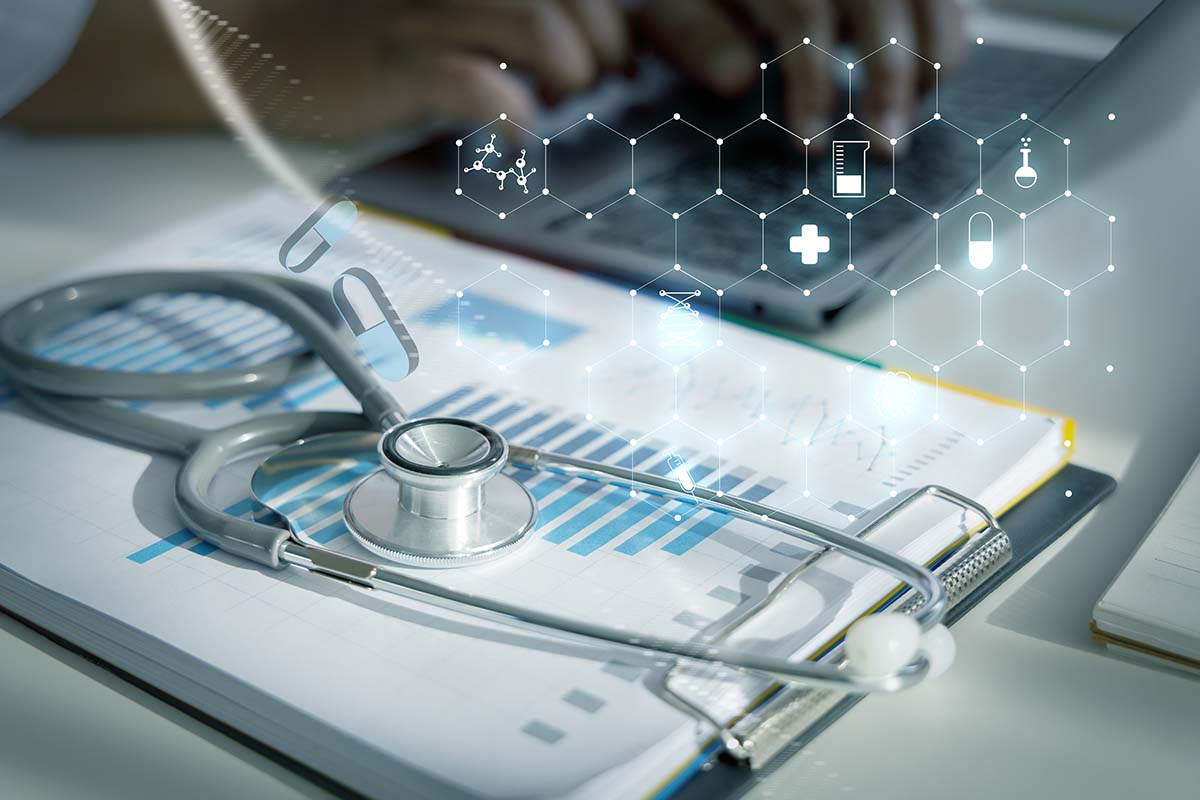The Transformative Power of Healthcare Data Analytics
KEY POINTS
- Data Analytics as a Healthcare Guide: Healthcare data analytics is a pivotal force, transforming patient care and operational efficiency by offering actionable insights from the vast data generated within the healthcare industry.
- Diverse Applications Enhancing Care: It spans clinical, operational, and financial aspects, with applications in improving diagnoses, treatment plans, resource management, and cost reduction, showcasing its broad impact on healthcare.
- Navigating Challenges for a Data-Driven Future: While promising, healthcare data analytics faces challenges in data standardization, privacy, and integration. Overcoming these hurdles is essential for leveraging its full potential in advancing healthcare.
In the dynamic realm of healthcare, where each diagnosis, treatment, and decision carries profound consequences, the significance of data analytics has emerged as a guiding light of hope and transformation.
In the modern age, healthcare data analytics takes its place as a powerful instrument, illuminating the path toward enhanced patient care, heightened operational efficiency, and cost-effective solutions. Its importance resonates across the healthcare industry, from the corridors of medical facilities to the boardrooms of healthcare organizations.
In this healthcare reform and innovation era, the transition to data-driven decision-making has transcended from a mere choice to an absolute necessity.
The capability to harness the wealth of information generated by healthcare systems and translate it into actionable insights can save lives, streamline operations, and elevate the quality of care bestowed upon patients.
The prowess of healthcare data analytics is rooted in its ability not only to tackle present-day challenges but also to lay the foundation for the healthcare of the future.
This article delves into the multifaceted realm of healthcare data analytics, its foundational principles, the diverse categories of healthcare data, and the groundbreaking applications reshaping patient care and the broader healthcare landscape.
We shall also scrutinize the role of predictive analytics, the concerns revolving around data security and privacy, and the promising trends poised to redefine healthcare as we know it. Join us on this illuminating expedition as we unveil how data-driven insights rejuvenate and metamorphose healthcare.
The Cornerstone of Healthcare Data Analytics
Healthcare data analytics is the systematic process of gathering, scrutinizing, and interpreting data from diverse sources within the healthcare sector to make informed decisions and drive enhancements.
It encompasses various data categories, spanning clinical, administrative, financial, and operational data, extending its influence across the entire healthcare ecosystem.
The domain of healthcare data analytics spans various applications, including:
- Clinical Analytics: Concentrating on patient data, clinical analytics capitalizes on electronic health records (EHRs), medical imagery, and laboratory findings to amplify diagnosis accuracy, treatment efficacy, and patient outcomes.
- Operational Analytics: This facet delves into the efficiency of healthcare operations, sifting through data related to resource allocation, patient logistics, and supply chain management to streamline procedures and curtail expenses.
- Financial Analytics: Financial data analytics is a crucial tool for healthcare institutions to manage budgets, revenue streams, and billing. It’s instrumental in pinpointing areas for cost reductions, enhancing reimbursement procedures, and ensuring fiscal sustainability.
- Population Health Analytics: In population health management, data analytics detects health trends within specific patient groups, granting healthcare providers the ability to proactively manage chronic conditions, allocate resources wisely, and enact preventive measures.
The Role of Data in Elevating Patient Care and Operational Efficiency
In the intricate and ever-evolving realm of healthcare, data occupies a central role in reshaping patient diagnoses and treatments and optimizing healthcare organizations’ operational dimensions.
In the quest for improved patient care, healthcare data analytics delivers an array of benefits:
- Augmented Clinical Decision-Making: Physicians and healthcare professionals gain access to comprehensive patient histories, medical records, and real-time data, enhancing their capacity for informed decisions regarding diagnoses and treatment plans.
- Predictive Analytics: Data analytics can forecast patient outcomes, permitting early intervention in critical situations and the proactive management of chronic ailments.
- Personalized Medicine: Through the analysis of patient data, healthcare practitioners can tailor treatment regimens to individual patient needs, heightening the prospects of successful treatment.
- Mitigated Medical Errors: Data analytics tools can identify and forestall medical errors, diminishing the likelihood of adverse incidents.
On the operational front, healthcare data analytics yields the subsequent advantages:
- Resource Allocation Efficiency: Hospitals and healthcare institutions can optimize resource distribution, mitigating wastage and guaranteeing the effective utilization of staff and equipment.
- Streamlined Administrative Processes: Administrative data analytics can simplify operations such as billing and insurance claims, diminishing administrative burdens and expenses.
- Enhanced Patient Flow: Data analysis can refine patient logistics within healthcare establishments, curtailing wait times and refining the overall patient experience.
- Cost Reduction: Detecting opportunities for cost savings and eliminating inefficiencies is a substantial advantage, particularly as healthcare expenditures continue to surge.
Varieties of Healthcare Data
The healthcare sector grapples with various data types in healthcare data analytics, each offering distinct insights and value. These data types can be broadly categorized into three primary domains: clinical data, administrative data, and financial data.
Clinical Data:
- Electronic Health Records (EHRs): EHRs encompass comprehensive patient data, including medical histories, treatment plans, medications, allergies, and laboratory test results. They hold immense value for healthcare professionals in delivering patient care.
- Medical Imaging Data: This encompasses X-rays, MRIs, CT scans, and other medical imagery. These are employed for diagnostic purposes and monitoring the progression of medical conditions.
- Laboratory and Pathology Data: Clinical laboratories provide data on blood tests, biopsies, and other diagnostic procedures. These results are instrumental in diagnosing and treating patients.
- Genomic Data: With the advent of genomics, genetic data is gaining prominence in understanding inherited conditions and customizing treatment plans.
- Patient-Generated Health Data (PGHD): Data generated by patients, including information from wearable devices and self-reported symptoms.
Administrative Data:
- Patient Registration and Demographics: This category encompasses patient names, addresses, contact information, and insurance particulars.
- Appointment Scheduling: Data linked to patient appointments, scheduling, and wait times.
- Claims and Billing Data: Administrative data comprises claims submissions, billing records, and insurance-related details. This data is pivotal for revenue cycle management.
- Resource Allocation Data: Information about staff schedules, room availability, and equipment allocation.
- Healthcare Facility Management Data: Data about managing healthcare facilities, such as maintenance, security, and compliance.
Financial Data:
- Revenue and Billing Data: This includes financial records of services rendered, insurance claims, and billing cycles.
- Cost Data: Financial data encompasses the costs associated with patient care, including the expense of medical procedures, medications, and equipment.
- Payer Data: Information regarding insurance providers, their policies, and reimbursement rates.
The Significance of Data Standardization and Interoperability
One of the foremost challenges in healthcare data analytics resides in the standardization and interoperability of healthcare data. Given the diversity of systems and data sources in the healthcare sector, data might be stored in various formats, employ distinct coding systems, and be housed in numerous databases.
This absence of standardization and interoperability can impede data exchange and collaboration between healthcare institutions and professionals.
To address these challenges, initiatives for data standardization and the development of interoperable systems are underway. These endeavors aim to ensure healthcare data can be effortlessly shared across different platforms and institutions.
This enhances data accuracy and reliability and facilitates data-driven decision-making, ushering in more effective patient care, operational efficiency, and research prospects. Data standardization further plays a pivotal role in safeguarding data privacy and compliance with regulatory requisites.
Harnessing the Power of Big Data in Healthcare
Big data is steering healthcare analytics into a transformative era, allowing organizations to collect, manage, and analyze extensive and diverse healthcare datasets. Several key fvitalors underpin this transformation:
- Advanced Analytics: Applying advanced analytical techniques, such as machine learning and artificial intelligence, to vast healthcare datasets has unlocked the potential for more precise diagnostics, predictive modeling, and personalized treatment plans.
- Data Integration: Big data analytics enables data integration from various sources, including electronic health records, medical imaging, genomics, and wearable devices. This comprehensive view of patient data supports holistic healthcare decision-making.
- Real-Time Insights: Healthcare organizations can tap into real-time data streams, offering dynamic insights into patient conditions and healthcare operations. This ability facilitates timely interventions, reducing errors and improving patient outcomes.
- Evidence-Based Medicine: The analysis of big data assists in identifying trends, best practices, and evidence-based approaches to treatment and care delivery, ultimately leading to improved clinical decision-making.
Challenges and Opportunities of Handling Extensive Healthcare Datasets
While big data presents significant opportunities for healthcare, it also brings forth challenges that necessitate attention:
Challenges:
- Data Privacy and Security: Healthcare data is susceptible and subject to strict privacy regulations. Managing and protecting patient data from breaches and unauthorized access is paramount.
- Data Quality: The sheer volume and variety of data can lead to data quality and accuracy issues. Ensuring data integrity is essential for informed decision-making.
- Interoperability: Integrating data from different sources and systems can be challenging due to the lack of interoperability standards.
- Data Governance: Establishing clear policies is necessary to ensure data consistency, compliance, and ethical use.
Opportunities:
- Early Disease Detection: Big data analytics can detect patterns and anomalies in patient data, enabling earlier disease detection and preventive care.
- Personalized Medicine: Individualized treatment plans can be created by analyzing patient genetics, medical history, and other factors, leading to more effective treatments.
- Resource Optimization: Healthcare organizations can optimize resource allocation and reduce operational costs by analyzing data on patient flow, bed utilization, and equipment maintenance.
- Research Advancements: Big data supports medical research by providing access to large datasets for clinical trials, genomics research, and epidemiological studies.
Innovative Applications of Big Data Analytics in Healthcare
Big data analytics is being leveraged in innovative ways in the healthcare industry:
- Predictive Analytics: Predictive models help forecast patient admission rates, disease outbreaks, and medication adherence, enabling proactive healthcare planning.
- Telemedicine: Big data facilitates telemedicine by connecting patients with healthcare providers, offering remote monitoring, and delivering personalized care recommendations.
- Drug Discovery: Researchers use big data analytics to identify potential drug candidates and predict their efficacy in treating diseases.
- Population Health Management: Big data is instrumental in population health management by identifying at-risk groups and developing targeted interventions and public health programs.
- Healthcare Fraud Detection: Analytics is used to identify fraudulent insurance claims and billing practices, saving healthcare organizations significant costs.
- Patient Experience Improvement: Big data helps healthcare providers analyze patient feedback and survey data to enhance patient experiences and satisfaction.
Boosting Operational Efficiency and Trimming Costs through Data Analytics
Data analytics serves as a linchpin in optimizing healthcare operations, allowing for enhanced resource management and cost reduction while simultaneously improving the quality of patient care.
In this section, we delve into how healthcare organizations can harness data analytics to amplify operational efficiency, substantiated by case studies exemplifying its tangible impact.
Spotting Cost-Efficient Opportunities and Resource Allocation
Data analytics bestows healthcare establishments with multiple avenues for recognizing cost-saving opportunities and effective resource allocation:
- Resource Utilization: Scrutinizing data on patient flow, bed occupancy, and staff scheduling empowers hospitals to optimize resource allocation. For instance, data-driven insights may recommend adjusting staffing levels during peak admission periods and curbing labor costs.
- Inventory Management: Effective supervision of medical supplies and equipment assumes paramount significance. Analytics can offer real-time inventory insights, curtailing wastage and ensuring the availability of crucial items.
- Preventive Maintenance: Predictive maintenance models can foretell equipment malfunctions, paving the way for proactive maintenance that slashes downtime and expensive emergency repairs.
- Supply Chain Efficiency: Data analytics lends a hand in streamlining the supply chain through procurement optimization, reducing inventory holding costs, and pinpointing cost-efficient suppliers.
- Revenue Cycle Management: Analytics streamlines the billing and claims process, resulting in diminished revenue leakage due to improved coding, claims submission, and accounts receivable management.
Preserving Patient Data Security and Privacy in Healthcare
Within the healthcare sector, the guardianship of vast quantities of sensitive patient data underscores the critical importance of data security and privacy. This section examines the significance of safeguarding healthcare data, the imperative adherence to healthcare data regulations such as HIPAA, and the methods and tactics deployed to shield patient privacy and data security.
The Vital Imperative of Shielding Sensitive Healthcare Data
Healthcare organizations are entrusted with extensive confidential patient information, encompassing medical histories, treatment records, diagnostic reports, and personal identifiers. The significance of safeguarding this data is paramount for several compelling reasons:
- Patient Trust: The preservation of patient data is integral to fostering trust. Patients must be confident that their health information is secure, enabling open and candid communication with healthcare providers.
- Legal Obligations: Stringent regulations mandate the protection of patient data by healthcare organizations. Noncompliance can lead to legal repercussions, financial penalties, and reputational damage.
- Data Monetization: Healthcare data is valuable for patient care and research, insurance, and marketing. Safeguarding data ensures it is not subjected to misuse or exploitation.
- Cybersecurity Threats: Given its valuable information, the healthcare industry is an attractive target for cyberattacks. A security breach can result in data theft, identity theft, and compromising patient safety.
Adherence to Healthcare Data Regulations, including HIPAA
In the United States, the Health Insurance Portability and Accountability Act (HIPAA) is the foremost regulation governing healthcare data privacy and security. HIPAA sets forth stringent standards for the protection of protected health information (PHI) and imposes obligations on healthcare providers, payers, and their business associates.
Measures and Strategies for Safeguarding Patient Privacy and Data Security
To ensure the security of data and the protection of patient privacy, healthcare organizations employ a multitude of measures and strategies, including:
- Access Controls: Rigorous access controls are instituted to restrict data access exclusively to authorized personnel. This encompasses user authentication, role-based access, and audit trails that monitor data access.
- Encryption: Data is encrypted at rest and in transit to safeguard it from unauthorized access. Encryption guarantees that even if data is intercepted, it remains indecipherable.
- Regular Auditing and Monitoring: The continuous monitoring and auditing of systems serve to promptly identify and rectify security vulnerabilities, thereby aiding in compliance through an audit trail.
- Employee Training: Healthcare personnel receive training in data security and privacy practices, which includes instructions on handling sensitive information, recognizing and averting phishing attacks, and identifying potential security threats.
- Incident Response Plans: Comprehensive incident response plans are developed to address data breaches or security incidents efficiently. This includes the requisite notification of affected parties by the law.
- Secure Communication: Safe methods for data transmission, such as virtual private networks (VPNs), safeguard data as it traverses between systems and facilities.
- Vendor Risk Assessment: The security practices of third-party vendors entrusted with healthcare data are assessed to ensure compliance with data security and privacy standards.
- Data Backups and Recovery: Data is regularly backed up, and disaster recovery plans are instituted to mitigate data loss during events like ransomware attacks.
- Secure Telehealth: With the increasing prevalence of telehealth, virtual care platforms must adhere to data protection regulations and are fortified with security measures.
- Security Updates: Systems and software are maintained with up-to-date security patches to guard against vulnerabilities.
Empowering the Future of Healthcare through Data Analytics
In summary, healthcare data analytics is driving a transformative wave in the healthcare industry. As demonstrated in this article, the application of data analytics in healthcare goes far beyond mere number crunching; it has the potential to revolutionize patient care, enhance operational efficiency, and advance medical research. Here are the key takeaways from our exploration:
- Data-Driven Transformation: Healthcare data analytics is more than just a buzzword; it is the guiding compass leading the industry toward improved patient outcomes. By harnessing the power of data, healthcare professionals can make informed, timely decisions that result in enhanced diagnostics, personalized treatment, and preventive care.
- Operational Efficiency: Streamlining healthcare operations through data analytics not only leads to cost savings but also to improved resource allocation and overall efficiency. Data-driven insights facilitate better decision-making, optimize workflows, and reduce waste, resulting in a more effective and sustainable healthcare system.
- Data Security and Privacy: With the increasing digitization of healthcare records and the utilization of patient data, maintaining stringent data security and privacy standards is paramount. Compliance with regulations like HIPAA and implementing robust security measures are non-negotiable within the industry.
As healthcare data analytics advances, it becomes evident that embracing this technology is essential for a healthier future. We encourage healthcare professionals, from clinicians to administrators, to enroll in healthcare data analytics courses to enhance their skills in this vital field.
By doing so, they can become the forefront of data-driven decision-makers and contribute to a healthcare landscape where every patient receives personalized, efficient, and high-quality care. This journey into the world of healthcare data analytics promises a brighter future for the industry and healthier lives for individuals around the globe.




















